Caroline Leavitt's Blog, page 10
March 11, 2020
The Nothing is Cancelled Book Tour. Sue Williams Silverman talks about HOW TO SURVIVE DEATH AND OTHER INCONVENIENCES
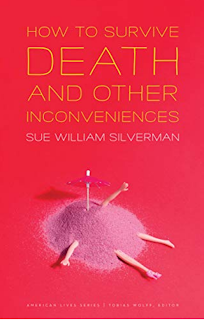
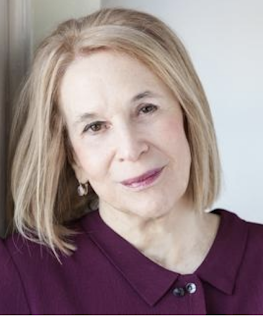 A memoir-in-essays, How to Survive Death and Other Inconveniences, was published March 1.
A memoir-in-essays, How to Survive Death and Other Inconveniences, was published March 1.Many are haunted and obsessed by their own eventual deaths, but perhaps no one as much as Sue William Silverman. This thematically linked collection of essays charts Silverman’s attempt to confront her fears of that ultimate unknown. Her dread was fomented in part by a sexual assault, hidden for years, that led to an awareness that death and sex are in some ways inextricable, an everyday reality many women know too well.
THE BOOK I LOVE:
Strung Out by Erin Khar.
MY FAVORITE INDIE BOOKSTORE:
And my favorite indie bookstore is The Bookman in Grand Haven, Michigan.
<!-- /* Font Definitions */ @font-face {font-family:"Cambria Math"; panose-1:2 4 5 3 5 4 6 3 2 4; mso-font-charset:0; mso-generic-font-family:roman; mso-font-pitch:variable; mso-font-signature:-536870145 1107305727 0 0 415 0;} @font-face {font-family:Calibri; panose-1:2 15 5 2 2 2 4 3 2 4; mso-font-charset:0; mso-generic-font-family:swiss; mso-font-pitch:variable; mso-font-signature:-536859905 -1073732485 9 0 511 0;} /* Style Definitions */ p.MsoNormal, li.MsoNormal, div.MsoNormal {mso-style-unhide:no; mso-style-qformat:yes; mso-style-parent:""; margin:0in; margin-bottom:.0001pt; mso-pagination:widow-orphan; font-size:12.0pt; font-family:"Times New Roman",serif; mso-fareast-font-family:Calibri;} a:link, span.MsoHyperlink {mso-style-noshow:yes; mso-style-priority:99; mso-style-parent:""; color:blue; text-decoration:underline; text-underline:single;} a:visited, span.MsoHyperlinkFollowed {mso-style-noshow:yes; mso-style-priority:99; color:#954F72; mso-themecolor:followedhyperlink; text-decoration:underline; text-underline:single;} p.xmsonormal, li.xmsonormal, div.xmsonormal {mso-style-name:x_msonormal; mso-style-unhide:no; mso-margin-top-alt:auto; margin-right:0in; mso-margin-bottom-alt:auto; margin-left:0in; mso-pagination:widow-orphan; font-size:12.0pt; font-family:"Times New Roman",serif; mso-fareast-font-family:"Times New Roman";} .MsoChpDefault {mso-style-type:export-only; mso-default-props:yes; font-size:10.0pt; mso-ansi-font-size:10.0pt; mso-bidi-font-size:10.0pt; mso-fareast-font-family:Calibri;}size:8.5in 11.0in; margin:1.0in 1.0in 1.0in 1.0in; mso-header-margin:.5in; mso-footer-margin:.5in; mso-paper-source:0;} div.WordSection1 {page:WordSection1;}</style>
Published on March 11, 2020 08:08
The Nothing is Cancelled Book Tour. Jennifer Rosner presents THE YELLOW BIRD SINGS
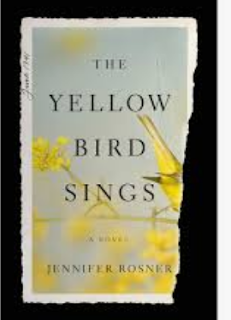
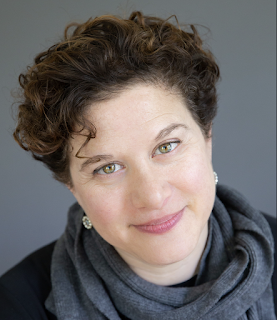
The Yellow Bird Sings came out on March 3; most of my events are being cancelled. The novel is about a Jewish mother and her five year old daughter, a musical prodigy, in hiding (together and apart) during WW2. It is about mother-daughter love, and the place of creativity and beauty in human survival.
BOOKS I LOVE:
The Secrets We Kept by Lara Prescott
The Last Train to London by Meg Waite Clayton.
INDIE BOOKSTORE I LOVE:
One of my favorite Indie bookstores is Amherst Books - the owner, Nat Herold, is incredibly supportive of local authors. <!-- /* Font Definitions */ @font-face {font-family:"Cambria Math"; panose-1:2 4 5 3 5 4 6 3 2 4; mso-font-charset:0; mso-generic-font-family:roman; mso-font-pitch:variable; mso-font-signature:-536870145 1107305727 0 0 415 0;} @font-face {font-family:Calibri; panose-1:2 15 5 2 2 2 4 3 2 4; mso-font-charset:0; mso-generic-font-family:swiss; mso-font-pitch:variable; mso-font-signature:-536859905 -1073732485 9 0 511 0;} @font-face {font-family:Tahoma; panose-1:2 11 6 4 3 5 4 4 2 4; mso-font-charset:0; mso-generic-font-family:swiss; mso-font-pitch:variable; mso-font-signature:-520081665 -1073717157 41 0 66047 0;} /* Style Definitions */ p.MsoNormal, li.MsoNormal, div.MsoNormal {mso-style-unhide:no; mso-style-qformat:yes; mso-style-parent:""; margin:0in; margin-bottom:.0001pt; mso-pagination:widow-orphan; font-size:12.0pt; font-family:"Times New Roman",serif; mso-fareast-font-family:Calibri;} .MsoChpDefault {mso-style-type:export-only; mso-default-props:yes; font-size:10.0pt; mso-ansi-font-size:10.0pt; mso-bidi-font-size:10.0pt; mso-fareast-font-family:Calibri;}size:8.5in 11.0in; margin:1.0in 1.0in 1.0in 1.0in; mso-header-margin:.5in; mso-footer-margin:.5in; mso-paper-source:0;} div.WordSection1 {page:WordSection1;}</style>
Published on March 11, 2020 08:05
The Nothing is Cancelled Book Tour. Jenny Block presents BE THAT UNICORN
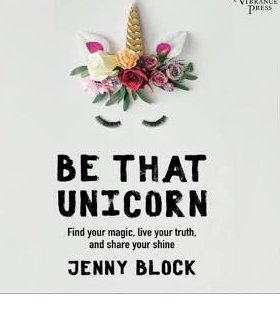
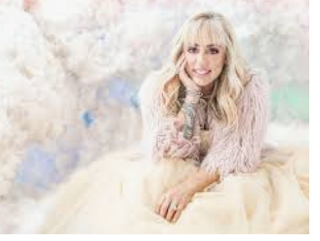
Already just published, Be That Unicorn is the modern antidote to our “mean girl” culture all about kicking ass at this thing called life while being kind to others and true to you in a world that seems to want to keep us from doing just that.
Says Jenny, That Unicorn is you. My mom has always said that people are drawn to me because I make everyone feel good about themselves. Throughout my life, people have echoed that sentiment. It’s the thing I love about myself the most: I’m the big sister, the BFF, the mom, the cheerleader, the coach…“the little unicorn that could” who everyone deserves.
One reader calls "Be That Unicorn” 150 pages of hug. I couldn’t agree more! It’s also a reminder that That Unicorn is not afraid to use her horn when she needs to. That Unicorn is a balanced creature and BTU shows the way to finding that balance.
A BOOK I LOVE: You Can Do All Things by Kate Allan because her drawings are fantastical and her words are life saving!
AN INDIE BOOKSTORE I LOVE: Book People in Austin, TX because it feels like the cozy and welcoming kind of place that would create if I had a bookstore of my own!
<!-- /* Font Definitions */ @font-face {font-family:Helvetica; panose-1:0 0 0 0 0 0 0 0 0 0; mso-font-charset:0; mso-generic-font-family:auto; mso-font-pitch:variable; mso-font-signature:-536870145 1342208091 0 0 415 0;} @font-face {font-family:"Cambria Math"; panose-1:2 4 5 3 5 4 6 3 2 4; mso-font-charset:0; mso-generic-font-family:roman; mso-font-pitch:variable; mso-font-signature:-536870145 1107305727 0 0 415 0;} @font-face {font-family:Calibri; panose-1:2 15 5 2 2 2 4 3 2 4; mso-font-charset:0; mso-generic-font-family:swiss; mso-font-pitch:variable; mso-font-signature:-536859905 -1073732485 9 0 511 0;} /* Style Definitions */ p.MsoNormal, li.MsoNormal, div.MsoNormal {mso-style-unhide:no; mso-style-qformat:yes; mso-style-parent:""; margin:0in; margin-bottom:.0001pt; mso-pagination:widow-orphan; font-size:12.0pt; font-family:"Times New Roman",serif; mso-fareast-font-family:Calibri;} .MsoChpDefault {mso-style-type:export-only; mso-default-props:yes; font-size:10.0pt; mso-ansi-font-size:10.0pt; mso-bidi-font-size:10.0pt; mso-fareast-font-family:Calibri;}size:8.5in 11.0in; margin:1.0in 1.0in 1.0in 1.25in; mso-header-margin:.5in; mso-footer-margin:.5in; mso-paper-source:0;} div.WordSection1 {page:WordSection1;}</style>
Published on March 11, 2020 08:02
The Nothing is Cancelled Book Tour. Kate Milliken presents Kept Animals
The Nothing is Cancelled Book Tour, promoting authors who have suffered cancellatiions because of the virus continues with another fabulous book!
Coming April 21, KEPT ANIMALS by Kate Milliken
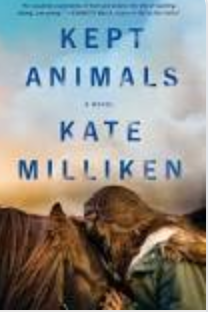
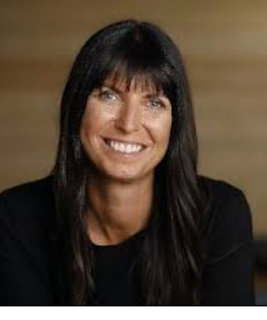
THE BOOKS I LOVE:
Current book that I keep pressing on others is BLACK LIGHT by Kimberly King Parsons and I am currently loving Sam Lansky’s debut novel Broken People (out in June). Also The Book of Unknown Americans by Cristina Henriquez. I could go on...
THE INDIE BOOKSTORES I LOVE:
Book Passage in Corte Madre, CA. And in LA, my home away from Home: Book Soup
Kept Animals is a bold, riveting debut novel of desire, betrayal, and loss, centering on three teenage girls, a horse ranch, and the tragic accident that changes everything.
Rory Ramos works as a ranch hand at the stable her stepfather manages in Topanga Canyon, California, a dry, dusty place reliant on horses and hierarchies. There she rides for the rich clientele, including twins June and Wade Fisk. While Rory may have unwittingly drawn the interest of out-and-proud June, she’s more intrigued by Vivian Price, the beautiful teenager with the movie-star father who lives down the hill. Rory’s blue-collar upbringing keeps her largely separate from the likes of the Prices—but, perched on her bedroom windowsill, Rory steals glimpses of Vivian swimming in her pool nearly every night.
After Rory’s stepfather is involved in a tragic car accident, the lives of Rory, June, and Vivian become inextricably bound together. Rory discovers photography, begins riding more competitively alongside June, and grows closer and closer to gorgeous, mercurial Vivian, but despite her newfound sense of self, disaster lurks all around her: in the parched landscape, in her unruly desires, in her stepfather’s wrecked body and guilty conscience. One night, as the relationships among these teenagers come to a head, a forest fire tears through Topanga Canyon, and Rory’s life is changed forever.
Kept animals is narrated by Rory’s daughter, Charlie, twenty years after that fateful 1993 fire. Realizing that the key to her own existence lies in the secret of what really happened that unseasonably warm fall, Charlie is finally ready to ask questions about her mother’s past. But with Rory away on assignment as a war photographer, Charlie knows she must unravel the truth for herself.
<!-- /* Font Definitions */ @font-face {font-family:"Cambria Math"; panose-1:2 4 5 3 5 4 6 3 2 4; mso-font-charset:0; mso-generic-font-family:roman; mso-font-pitch:variable; mso-font-signature:-536870145 1107305727 0 0 415 0;} @font-face {font-family:Calibri; panose-1:2 15 5 2 2 2 4 3 2 4; mso-font-charset:0; mso-generic-font-family:swiss; mso-font-pitch:variable; mso-font-signature:-536859905 -1073732485 9 0 511 0;} @font-face {font-family:Cambria; panose-1:2 4 5 3 5 4 6 3 2 4; mso-font-charset:0; mso-generic-font-family:roman; mso-font-pitch:variable; mso-font-signature:-536870145 1073743103 0 0 415 0;} /* Style Definitions */ p.MsoNormal, li.MsoNormal, div.MsoNormal {mso-style-unhide:no; mso-style-qformat:yes; mso-style-parent:""; margin:0in; margin-bottom:.0001pt; mso-pagination:widow-orphan; font-size:12.0pt; font-family:"Times New Roman",serif; mso-fareast-font-family:Calibri;} .MsoChpDefault {mso-style-type:export-only; mso-default-props:yes; font-size:10.0pt; mso-ansi-font-size:10.0pt; mso-bidi-font-size:10.0pt; mso-fareast-font-family:Calibri;}size:8.5in 11.0in; margin:1.0in 1.0in 1.0in 1.0in; mso-header-margin:.5in; mso-footer-margin:.5in; mso-paper-source:0;} div.WordSection1 {page:WordSection1;}</style>
Published on March 11, 2020 07:59
The Nothing is Cancelled Book Tour : Cara Black and Three Hours in Paris
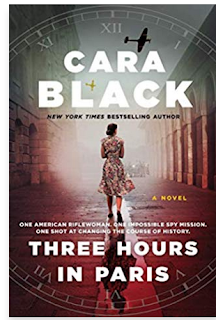

Because so many authors are having events and tours cancelled due to the virus, and because early promotion is so important to books, authors and bookstores, the Nothing is Cancelled Book Tour is continuing right here!
THREE HOURS IN PARIS, coming April 7, 2020
In June of 1940, when Paris fell to the Nazis, Hitler spent a total of three hours in the City of Light - abruptly leaving, never to return. To this day, no one knows why.
Kate Rees, a young American markswoman, has been recruited by British intelligence to drop into Paris with a dangerous assignment: assassinate the Führer. Wrecked by grief after a Luftwaffe bombing killed her husband and infant daughter, she is armed with a rifle, a vendetta, and a fierce resolve. But other than rushed and rudimentary instruction, she has no formal spy training. Thrust into the red-hot center of the war, a country girl from rural Oregon finds herself holding the fate of the world in her hands. When Kate misses her mark and the plan unravels, Kate is on the run for her life in Occupied Paris - all the time wrestling with the suspicion that the whole operation was a set-up.
THE BOOK I'M READING THAT I LOVE: Pretty As a Picture by Elizabeth Little @elizabethlittleTHE INDIE BOOKSTORE I LOVE: McIntyre’s Books near Chapel Hill @mcibooks
<!-- /* Font Definitions */ @font-face {font-family:"Cambria Math"; panose-1:2 4 5 3 5 4 6 3 2 4; mso-font-charset:0; mso-generic-font-family:roman; mso-font-pitch:variable; mso-font-signature:-536870145 1107305727 0 0 415 0;} @font-face {font-family:Calibri; panose-1:2 15 5 2 2 2 4 3 2 4; mso-font-charset:0; mso-generic-font-family:swiss; mso-font-pitch:variable; mso-font-signature:-536859905 -1073732485 9 0 511 0;} /* Style Definitions */ p.MsoNormal, li.MsoNormal, div.MsoNormal {mso-style-unhide:no; mso-style-qformat:yes; mso-style-parent:""; margin:0in; margin-bottom:.0001pt; mso-pagination:widow-orphan; font-size:12.0pt; font-family:"Times New Roman",serif; mso-fareast-font-family:Calibri;} .MsoChpDefault {mso-style-type:export-only; mso-default-props:yes; font-size:10.0pt; mso-ansi-font-size:10.0pt; mso-bidi-font-size:10.0pt; mso-fareast-font-family:Calibri;}size:8.5in 11.0in; margin:1.0in 1.0in 1.0in 1.25in; mso-header-margin:.5in; mso-footer-margin:.5in; mso-paper-source:0;} div.WordSection1 {page:WordSection1;}</style>
Published on March 11, 2020 07:55
The Nothing is Cancelled Booktour: Clarissa Goenawan and THE PERFECT WORLD OF MIWAKO SUMIDA
First up on the Nothing is Cancelled Booktour, my posts for authors who have had events cancelled! We all want to support authors and indie bookstores, so keep spreading the word about these books and other books you love and indie bookstores and libraries you love all over social media!
THE PERFECT WORLD OF MIWAKO SUMIDA by Clarissa Goenawan came out March 10 and you can order wherever books are sold!
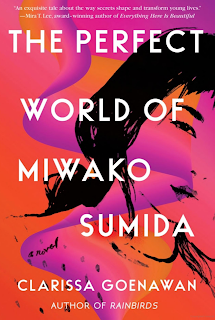
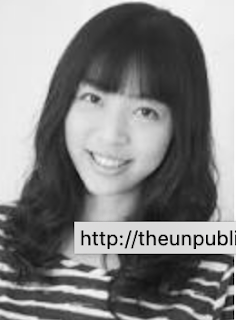
A Literary Hub Most Anticipated Book of 2020
From the critically acclaimed author of Rainbirds comes a novel of tragedy and dark histories set in Japan.
University sophomore Miwako Sumida has hanged herself, leaving those closest to her reeling. In the months before her suicide, she was hiding away in a remote mountainside village, but what, or whom, was she running from?
Ryusei, a fellow student at Waseda who harbored unrequited feelings for Miwako, begs her best friend Chie to bring him to the remote village where she spent her final days. While they are away, his older sister, Fumi, who took Miwako on as an apprentice in her art studio, receives an unexpected guest at her apartment in Tokyo, distracting her from her fear that Miwako’s death may ruin what is left of her brother’s life.
Expanding on the beautifully crafted world of Rainbirds, Clarissa Goenawan gradually pierces through a young woman’s careful façade, unmasking her most painful secrets.
Published on March 11, 2020 07:52
March 10, 2020
Authors with new books out, with events cancelled because of the coronavirus--never fear. Reading With Robin's Robin Kall Homonoff is here with Authorpalooza, Friday 13th, an all day author interview event
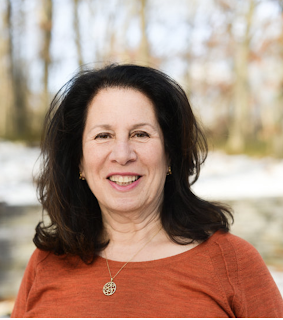

Hey authors! Got a new book coming out? Have you had events cancelled? (I have, sigh...) The Coronavirus is impacting everything and everyone. And it doesn't look like it is going to get better some time soon. I know countless other authors worrying over cancelled tour dates, cancelled festival dates, and bookstore readings--all the things that help books find readers.
But all is not lost. Because my beloved friend and the angel of readers and writers, Robin Kall Homonoff isn't going to let that happen.
Robin's the creator of the wise, witty and wonderful Reading With Robin podcast. With her daughter Emily (If you love Robin, you also love Emily) they run the Cardigan Connection Reading Series, which is always packed. Robin knew that with all the cancelling of events, there was still something she could do. And fast.
This Friday, she's starting AUTHORPALOOZA, an all day podcast interviewing a huge variety of authors. If you are an author with a new book coming out or with events already cancelled, please contact Robin here through her FB page.
Come here and here for more information and to join the Reading With Robin community. And I'm taking this opportunity to give back to Robin and interview HER. Thank you, Robin!
How did you think of this fabulous idea?
We hosted the amazing Lily King last night and I had been thinking for the past week that it might be our last in-person event for a while. Once it was announced taht the Tucson Book Festival was cancelled, along with other author events, I knew that this was something I could do to help get the word out about new books. It's crucial for books to get as much attention as possible when they first come out, and many of these authors are like family to me after all of these years. I've been doing this since 20002!
Why was Reading With Robin the natural choice for this to happen?
I have the most readers on this platform so it was a natural place to host virtually.
Do you ever sleep?
Ha! yes, I sure do, but I have a feeling not so much this week.
How can readers and writers support YOU?
Thank you for asking. The most appreciated would be to join me on the RB page, Reading with Robin. Give it a like, if you are so inclined. Follow on Instagram @RobinKallink. Tune into the Reading with Robin Podcast on Itunes...the usual suspects!
Published on March 10, 2020 18:07
March 3, 2020
One Wedding Dress. Three Generations of Women. Brenda Janowitz talks about THE GRACE KELLY DRESS.
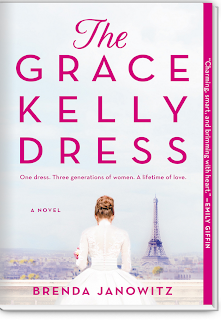
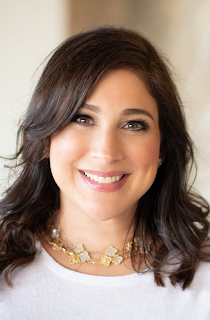
"Janowitz’s latest is just like the multi-generational wedding dress of the title: elegant, layered, and utterly original. She once again delivers a powerful story brimming with love.” Fiona Davis, bestselling author of The Chelsea Girls
"This is a book that has to be added to your nightstand immediately!" Jane Green, bestselling author of The Friends We Keep
I've known and loved Brenda for years and I'm so thrilled that she has a new novel out, about one wedding dress and three generations of women, and it's getting major league buzz, too!
Brenda is the author of five novels and the Books Correspondent for PopSugar. Her sixth novel, THE GRACE KELLY DRESS, will be published by Harper Collins/ Graydon House in March 2020. Her work has also appeared in The New York Times, The Washington Post, Salon, Redbook, USA Today, Bustle, The Forward, the New York Post, Publisher’s Weekly, Hello Giggles, Writer’s Digest Magazine, WritersDigest.com, and xojane.
Brenda, thank you so much for being here!
I always want to know what’s haunting an author when they start a book, or what question they were thinking about. What was it for you with The Grace Kelly Dress?
My agent sent me a story from The Today Show about an heirloom wedding gown that had been passed down through a family to eleven brides. I was immediately taken with this idea— something that had been passed down over time through so many different types of women, something that would mean something different to each one. I couldn’t stop thinking about it. How the dress had changed, how fashion had changed, how the family had changed.
I write often about multiple generations of a family, so this kernel of an idea was the perfect jumping off point for me. As I formed the protagonist in my mind’s eye, more questions developed—would she even want to wear such a dress? Why does a mother want a daughter to wear her wedding gown? What did the dress mean to the woman who created it? With all of these questions swirling, I knew I had my next novel.
I love the idea of one wedding dress (and who can resist a dress that is called Grace Kelly?) binding three generations of women together, yet each woman brings something specifically unique to her wearing of that dress. Do you have a dress like that in your own life?
Oh, how I wish I had something like that in my life! But alas, I do not. The wedding dress described in the novel is an heirloom wedding gown, inspired by the wedding dress that American actress Grace Kelly wore when she married Prince Rainier of Monaco. To me, it’s the most iconic wedding gown of all time.
In fact, when it came time to shop for my own wedding dress, I found myself especially drawn to the gowns that featured details that served as a homage to that famous piece of history. The gown I wore down the aisle had a delicate ribbon around the waist, a nod to Grace Kelly’s elegant cummerbund, and had silk bows that ran down the back, just like Grace Kelly’s dress. (So, perhaps I did have a dress like that, after all.)
Clothes, like music, have such deep symbolism for me—and for all of us, I think. They catapult you back in time, or they have all your hopes and dreams in every thread. Can you talk about this please?
Items of clothing can be so incredibly meaningful! The way we adorn ourselves can say so much about who we are and where we came from.
This is even more so when we speak about a wedding gown. The dress a woman chooses says so much about her—the way she’s decided to present herself on one of the most meaningful days of her life. The way she wants to look. The way she wants to be seen.
Wedding dresses have always been a source of fascination to me, for this reason. And I suppose you could say, I’m still obsessed. One of the things I wanted to tackle in this novel was the way the dress was made. Would such a dress carry the hopes and dreams of the woman who created it?
You are known and loved in the writing community because you do so much for other writers. (And thank you!) What advice would you give writers today who want to build community and be as generous as you are?
Thank you so much, Caroline! I think that the writing community would say the same thing about you!
It’s really all about relationships. When you’re a writer, it can be so isolating. So, it’s wonderful to have a community of people you can turn to for advice and encouragement. A sort of water cooler, if you will.
For me, the best advice is to just create friendships that are organic and real. Find people you like and respect. Support your friends. When you love someone’s work, shout it from the rooftops. Don’t expect anything in return. Remember: a rising tide lifts all ships.
You’ve written 5 knockout novels. Do you feel that each novel builds on the next, or are you like me, stricken with writers’ amnesia where every project becomes something brand new? Has your writing changed over the years and novels?
Thank you, Caroline! I do, in many ways, think that each novel builds on the next. And certainly, I’m a different person as I start each novel.
But I agree with you: whenever I start a new novel, it feels like I’ve never done it before, like I have no idea how to do it another time. It feels like a mountain I’ll never climb again.
Of course, I jump in anyway. And I find that as my life has changed, so has my writing. When I sold my first novel, I was a single attorney living in New York City. Now, I’m a married mother of two, writing novels full time and freelancing. I see the world differently in many ways, and I’d like to think that my writing reflects that. I used to love the Dorothy Parker quote: “I hate writing; I love having written.” But at this stage of my writing career, I’ve realized that the opposite is actually true: I love the process of writing. I love figuring out the world and my place in it through my work. I love seeing the world, through my fictional characters, in different ways.
I do hope that over time, my writing has deepened, and become more true.
What’s obsessing you now and why?
That’s a dangerous question because I get easily obsessed! But right now, I cannot stop thinking about Margaret Atwood’s sequel to The Handmaid’s Tale, The Testaments. I re-read The Handmaid’s Tale just before beginning The Testaments, and I couldn’t get over how incredible the writing was, how prescient it feels in today’s world, and how much of the book I’d forgotten (and how much I remembered). The Testaments was such a completely different book than The Handmaid’s Tale, and it was astonishing to watch a master at work, handling a world she’d created, all these years later. I cannot stop thinking about these two books, and as great writing always does, I feel humbled as I start writing my next novel.
What question didn’t I ask that I should have?
I may not have an heirloom dress, but I do have a number of family heirlooms that are incredibly meaningful to me.One of my most prized possessions is a ring that my grandmother gave to me. That ring is my childhood wrapped up in a single piece of jewelry— I can still picture her wearing it, in my mind’s eye. I wear it most days, but especially on days when I feel like I need her there with me. In particularly difficult situations, it’s like I can feel her there besides me, guiding me. On special days, like the day of my last book launch, I wore it to bring her with me, to show her that I’ve made my dream come true. I’ll wear it on tour for The Grace Kelly Dress. And I’m wearing it right now. <!-- /* Font Definitions */ @font-face {font-family:"Cambria Math"; panose-1:2 4 5 3 5 4 6 3 2 4; mso-font-charset:0; mso-generic-font-family:roman; mso-font-pitch:variable; mso-font-signature:-536870145 1107305727 0 0 415 0;} @font-face {font-family:Calibri; panose-1:2 15 5 2 2 2 4 3 2 4; mso-font-charset:0; mso-generic-font-family:swiss; mso-font-pitch:variable; mso-font-signature:-536859905 -1073732485 9 0 511 0;} @font-face {font-family:"Avenir Book"; panose-1:2 0 5 3 2 0 0 2 0 3; mso-font-charset:0; mso-generic-font-family:auto; mso-font-pitch:variable; mso-font-signature:-2147483473 1342185546 0 0 155 0;} /* Style Definitions */ p.MsoNormal, li.MsoNormal, div.MsoNormal {mso-style-unhide:no; mso-style-qformat:yes; mso-style-parent:""; margin:0in; margin-bottom:.0001pt; mso-pagination:widow-orphan; font-size:12.0pt; font-family:"Times New Roman",serif; mso-fareast-font-family:Calibri;} .MsoChpDefault {mso-style-type:export-only; mso-default-props:yes; font-size:10.0pt; mso-ansi-font-size:10.0pt; mso-bidi-font-size:10.0pt; mso-fareast-font-family:Calibri;}size:8.5in 11.0in; margin:1.0in 1.0in 1.0in 1.0in; mso-header-margin:.5in; mso-footer-margin:.5in; mso-paper-source:0;} div.WordSection1 {page:WordSection1;}</style><br /><div class="MsoNormal"><br /></div><style><!-- /* Font Definitions */ @font-face {font-family:"Cambria Math"; panose-1:2 4 5 3 5 4 6 3 2 4; mso-font-charset:0; mso-generic-font-family:roman; mso-font-pitch:variable; mso-font-signature:-536870145 1107305727 0 0 415 0;} @font-face {font-family:Calibri; panose-1:2 15 5 2 2 2 4 3 2 4; mso-font-charset:0; mso-generic-font-family:swiss; mso-font-pitch:variable; mso-font-signature:-536859905 -1073732485 9 0 511 0;} /* Style Definitions */ p.MsoNormal, li.MsoNormal, div.MsoNormal {mso-style-unhide:no; mso-style-qformat:yes; mso-style-parent:""; margin:0in; margin-bottom:.0001pt; mso-pagination:widow-orphan; font-size:12.0pt; font-family:"Times New Roman",serif; mso-fareast-font-family:Calibri;} a:link, span.MsoHyperlink {mso-style-priority:99; mso-style-parent:""; color:#0563C1; text-decoration:underline; text-underline:single;} a:visited, span.MsoHyperlinkFollowed {mso-style-noshow:yes; mso-style-priority:99; color:#954F72; mso-themecolor:followedhyperlink; text-decoration:underline; text-underline:single;} .MsoChpDefault {mso-style-type:export-only; mso-default-props:yes; font-size:10.0pt; mso-ansi-font-size:10.0pt; mso-bidi-font-size:10.0pt; mso-fareast-font-family:Calibri;}size:8.5in 11.0in; margin:1.0in 1.0in 1.0in 1.25in; mso-header-margin:.5in; mso-footer-margin:.5in; mso-paper-source:0;} div.WordSection1 {page:WordSection1;}</style>
Published on March 03, 2020 09:44
Oh, yes, a Reece's Bookclub Pick! Amanda Eyre Ward talks about THE JETSETTERS, reinventing the writing wheel, families, comedy and so much more
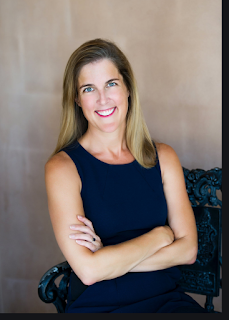
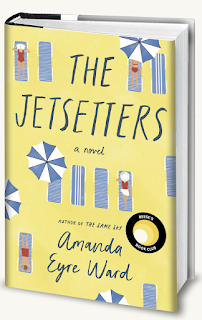
“Ward nails how family expeditions are ruined and saved, over and over again, by fleeting moments of connection and the consensus to survive without killing one another.”
— The New York Times Book Review
I've been lucky enough to know Amanda Eyre Ward for years. You can't find someone warmer, smarter, and more supportive and so, I am breaking out the champagne because yep, yep, yep, her latest novel THE JETSETTERS is a Reece BookClub Pick!
Amanda is talso he author of Sleep Toward Heaven, How to Be Lost, Love Stories in This Town, Forgive Me, Close Your Eyes, The Same Sky, The Nearness of You, and The Jetsetters. Her bestselling novels have been featured in People Magazine, The New York Times, and more. Amanda's work has been optioned for film and television and translated into fifteen languages.
Thank you so much for being here, Amanda!
I always think that writers are haunted into writing their books, that they are looking for answers to something and hope to find it in a novel. What was haunting you?
What a great question!
Last year, I saw an Oprah video explaining how to create a “vision board.” As instructed, I ripped out pictures in magazines that spoke to me, without really thinking. When I lay them all out on my living room rug, I realized that they were all photos of Europe: Greece, Spain, France, Italy. In my life as a working mother of three, I longed for the glamour of travel, the tastes of Europe. I thought, “Someday, I will write a bestseller and take my children to Europe.”
But the next morning, I woke with the story of The Jetsetters. I saw Charlotte, yearning to reconnect with her adult children. (I saw her in a terrycloth beach cover-up and gold earrings, with strappy sandals she’d bought in Athens.)
As the book developed, I found myself thinking of my childhood. My mom (like Charlotte) had raised me and my two siblings as a single mother. We’d taken on roles within our small family, and I wondered if we were destined to remain in these roles, or if we could ever break free of them.
I’ve had some crazy trips with my sisters and mother, and there’s something about close proximity that forces long-buried secrets to the surface. I wanted the Perkins family to lay their truths bare, and then to emerge feeling peaceful.
I also wanted Charlotte to fall in love!
I absolutely love that your protagonist Charlotte is seventy years old, giving us a great new perspective on love, life, family, and the possibilities that life can show us, no matter what the age. Can you talk about this please?
I’d love to. I wanted to inhabit a seventy-year-old woman, to know what she would love physically, and to understand her (and OK, my) desire. Women’s desire is so complicated and individual—for some, feeling safe is the ultimate turn-on. Charlotte might be seventy, but she is also still the teenage girl who discovered sex with a famous painter, who has long had sexual fantasies that she’s felt ashamed about. I wanted her to love herself enough to lea into a deep kiss…and more.
You’ve written so many critically acclaimed novels and I was wondering, do you feel that you build on what you’ve learned in writing one novel when you move onto the next, or is it like starting brand new? And what did writing this particular novel teach you?
For me, it feels as if I’m re-inventing the wheel every single time. (How about you?) I always think I have a foolproof method—I use index cards, story arcs; I use long afternoons lying still and listening—but every single time the characters just laugh. It takes me many, many drafts to fully realize a novel.
I actually thought a comic novel would be easy, but it was not. My editor, Kara Cesare, made me really take apart each character, forcing me to go deeper into who they were…the memories that made each adult, the past selves who rose up at inopportune times. I needed to learn to write in a different way: this book required slow, deep insights to be written on the page, unlike the spare style I’d used in previous novels. I am very thankful to have an editor who saw what I could do, and pushed me (with great intelligence and kindness) to get there.
The best part about my career is that I can write to amazing authors such as you, Meg Wolitzer, Doug Dorst, Lisa Cron, Allison Lynn, Vendela Vida, Masha Hamilton, and Leah Stewart and ask them, “How the hell did you dothis?” I probably have another whole book of emails and letters about the writing of The Jetsetters.
In fact, I wrote one of my best friends, the Pulitzer-prize-winning Andrew Sean Greer, when I was close to abandoning The Jetsetters. I sent him the Prologue, saying, “Is this any good? Should I give this up?” and he wrote:
“I LOVE the prologue, love it love it love it. This is some of your best writing, Amanda, you must know it!”
I did not know it. I thought I couldn’t write this book. But honestly, Andy’s e-mail got me back to work. And I am so proud of this novel.
What kind of writer are you now? How has it changed for you?
I have just finished my first nonfiction book, and am back to work on a novel. I’m one lucky writer, and that’s for sure! I wrote every day in my pajamas until I pick up my seven-year-old daughter at three o’clock. And then my two boys and my husband come home and I try not to think about work until the next morning…but I am a terrible insomniac, and often find myself scribbling in a notebook at 3a.m.!
What’s obsessing you now and why?
My husband is a Geophysicist working with sequestering CO2 to keep carbon emissions under control. I think a lot about climate change and human rights violations and the unaccompanied minor kids I met wile researching The Same Sky.
The novel I am just beginning is the story of three mothers who think they can be vigilant enough to keep their children safe. One mother sells doomsday bunkers to tech billionaires in sweatpants. One mother is Mexican by birth, but believes that her money and American husband separates her from the influx of migrants at the Texas/Mexico border. The last mother is a single mother who believes that if she can keep her shameful past from her son, he will grow up without the anxieties that plague her. Needless to say, all three women are wrong!
What question didn’t I ask that I should have?
I love all of these questions, but here is one: Amanda, what was the best thing you ate during your “research trip” to Europe? And the answer is grilled octopus on Santorini Island, Greece!
Published on March 03, 2020 09:09
February 23, 2020
Who controls women's bodies and their minds? Clare Beams talks about her raved-about novel THE ILLNESS LESSON, how the 19th Century is relevant to today, mass suggestion, how we control our worlds, and so much more
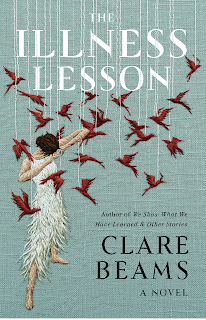
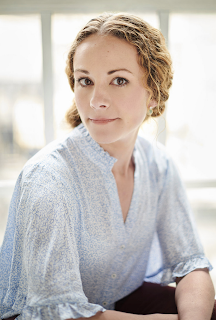
Part of being an author is getting arcs! And when Claire Beams' THE ILLNESS LESSON came through the door, I immediately snatched it up. How could I not? About a mysterious flock of red birds who descend on a 19th Century girls school, about the power men insist of imposing on women, and so much more, the book is a marvel. And I'm not the only one to think so. Just look at all this:
NEW YORK TIMES EDITORS’ CHOICE
TIME MAGAZINE BEST BOOKS FOR FEBRUARY
ENTERTAINMENT WEEKLY BEST BOOKS FOR FEBRUARY
THE SUNDAY TIMES WHAT TO READ IN 2020
VANITY FAIR’S THRILLERS FOR WINTER
ESQUIRE’S BEST BOOKS TO ELEVATE YOUR READING LIST IN 2020
O, THE OPRAH MAGAZINE BEST OF FEBRUARY
LIT HUB’S MOST ANTICIPATED BOOKS OF 2020
STYLIST MAGAZINE’S YEAR OF DEBUT NOVELS, 2020
BOOKRIOT’S MUST-READ DEBUT NOVELS OF 2020
BUSTLE’S MOST ANTICIPATED BOOKS OF FEBRUARY
THE MILLIONS MOST ANTICIPATED BOOKS OF FEBRUARY
“Astoundingly original, this impressive debut belongs on the shelf with your Margaret Atwood and Octavia Butler collections.”–New York Times Book Review
“The Illness Lesson is a brilliant, suspenseful, beautifully executed psychological thriller. With power, subtlety, and keen intelligence, Clare Beams has somehow crafted a tale that feels like both classical ghost story and like a modern (and very timely) scream of female outrage. I stayed up all night to finish reading it, and I can still feel its impact thrumming through my mind and body. A masterpiece.” —ELIZABETH GILBERT, AUTHOR OF CITY OF GIRLS “Stunningly good—a brainy page-turner that's gorgeous and frightening in equal measure. The Illness Lesson dazzled me.” —Leni Zumas, author of Red Clocks
Clare Beams is no stranger to awards. Her story collection, We Show What We Have Learned, won the Bard Fiction Prize, was longlisted for the Story Prize, and was a Kirkus Best Debut of 2016, as well as a finalist for the PEN/Robert W. Bingham Prize, the New York Public Library’s Young Lions Fiction Award, and the Shirley Jackson Award.
Best of all, in interviewing Clare, I learned that not only did she live in my hometown, Boston, but she now lives in Pittsburgh, where I lived for a time, AND she even knew where my old apartment (hilariously called The Lion's Head) was!
Thank you so much, Clare, for both the amazing read and the interview.
I always, always want to know what was haunting you that got you writing this fabulous novel? And did that haunting change as you were writing?
When I started The Illness Lesson, I had just finished six years of teaching high school English, and I think a lot of the questions teaching raised for me—about power, about students and our responsibilities to them—haunt this book. More concretely, the book was sparked by a visit to Fruitlands in Massachusetts, site of a failed commune established by Louisa May Alcott’s father, Bronson Alcott. The place itself is very beautiful, and what happened there had beautiful origins—lots of lovely and noble ideas about humans and their worth—and yet was so misguided in a practical sense (they had a lot of complicated and poorly thought-through theories about what they should and shouldn’t eat, no one really knew how to farm, they all almost starved to death, etc.). That kind of contradiction haunted me, and so did the question of who might end up paying for a contradiction of that kind. And as I wrote, the girls and Caroline and their plight began to haunt me more and more.
What was it like to move from a short story collection to a novel? (I always say that writing a story is like an intense affair, but a novel is a long, satisfying marriage.) Did you feel that there were new lessons you had to learn, and if so, what were they?
I like your analogy! That feels right to me. A story’s premise doesn’t necessarily have to obsess me for long (though it does have to obsess me very deeply)—but this novel had to concern questions that felt inexhaustible in order to be capable of drawing me in over the course of seven years, even as my whole life changed. Practically speaking, I was writing many of the stories in my collection and just about all of this novel as a parent of very young children, and I just had a much easier time finishing the stories. The story form lent itself to the kind of time I had—short, intensely focused pockets—much more naturally than the novel form did. Once I had a draft of the novel, I spent whole years kind of picking away at it in the little bits of time I could find, instead of tackling the massive overhaul I knew was in order, because it was so hard to find the concentrated stretch of months I needed in order to hold the whole thing in my head. I learned a practical lesson about the necessity of finding that kind of time, and about what it took to make it happen (a full-family effort, basically). Craft-wise, the lessons I learned over the course of writing the novel had a lot to do with pacing—I had to figure out how to deliver just enough information while keeping the story moving. Of course that’s part of the work in a story too, but it felt more challenging here. I suspect it’s a balance I’ll have to learn all over again for the next project, because I’m betting every novel requires something different.
Why did you set the book in the so-called progressive 19th century? And what fascinated you the most about the research?
I adored Little Women as a kid—I read it dozens of times—and over the years I just sort of stayed fascinated and kept reading about the thinkers of that time. And the more I read, the more obsessed I became with the Transcendentalists and some of the tensions in their philosophy, the way many of their ideas were so beautiful and uplifting and based on the fundamental worth of all people, but still there were all these women (sometimes utterly brilliant women, like the Peabody sisters and the Louisa May Alcott) around the brilliant men, facilitating their lives in ways that often went unacknowledged. I wanted to explore those tensions dramatically—and while I’ve set them in the 19th century here, as a sort of means of intensification, I don’t think we’re actually done with them. Research-wise I loved learning about all of these thinkers, and I also did lots of interesting and unsettling reading about Victorian medicine.
This book, though set in the 19th Century feels very appropriate for today. The school tries to be modern, with its emphasis on free thinking, but when things turn dark, the men take over, and unfortunately that means judging women’s maladies and denying them any power of their own. Sigh. Would you agree with me that “finding productive ways of living in the world as it is” might not be the best path, and that women, instead, should perhaps live in the world as they want it to be?
Oh, I so want to agree with you! What I can say is that in this novel I think I’m raising that question and pointing out why it can be such a difficult one to answer, more than trying to answer it, since probably everyone’s answer is different. As for my own personal answer, yes, I think to the extent it’s possible, we should live in the world as we want it to be, but I also think we should be ready to bump up against the world’s designs for us and to work to change those designs when we have to. I wish we didn’t have to—and I really, really wish my daughters wouldn’t have to. It can take so much time.
What’s obsessing you now and why?
My new project takes some of my constant obsessions—what it means to be a woman in the world, how we exert power over one another—and bends them toward the state of pregnancy.
What question didn’t I ask that I should have?
You did a wonderful job! I’ve been waiting for someone to ask me about the plot of the novel-within-the-novel, the melodramatic gothic thriller The Darkening Glass, because at one point I had the whole thing pretty much worked out—but it’s probably best lost to the sands of time!<!-- /* Font Definitions */ @font-face {font-family:"Cambria Math"; panose-1:2 4 5 3 5 4 6 3 2 4; mso-font-charset:0; mso-generic-font-family:roman; mso-font-pitch:variable; mso-font-signature:-536870145 1107305727 0 0 415 0;} @font-face {font-family:Calibri; panose-1:2 15 5 2 2 2 4 3 2 4; mso-font-charset:0; mso-generic-font-family:swiss; mso-font-pitch:variable; mso-font-signature:-536859905 -1073732485 9 0 511 0;} /* Style Definitions */ p.MsoNormal, li.MsoNormal, div.MsoNormal {mso-style-unhide:no; mso-style-qformat:yes; mso-style-parent:""; margin:0in; margin-bottom:.0001pt; mso-pagination:widow-orphan; font-size:12.0pt; font-family:"Times New Roman",serif; mso-fareast-font-family:Calibri; mso-fareast-theme-font:minor-latin;} .MsoChpDefault {mso-style-type:export-only; mso-default-props:yes; mso-fareast-font-family:Calibri; mso-fareast-theme-font:minor-latin;}size:8.5in 11.0in; margin:1.0in 1.0in 1.0in 1.25in; mso-header-margin:.5in; mso-footer-margin:.5in; mso-paper-source:0;} div.WordSection1 {page:WordSection1;}</style><style><!-- /* Font Definitions */ @font-face {font-family:"Cambria Math"; panose-1:2 4 5 3 5 4 6 3 2 4; mso-font-charset:0; mso-generic-font-family:roman; mso-font-pitch:variable; mso-font-signature:-536870145 1107305727 0 0 415 0;} @font-face {font-family:Calibri; panose-1:2 15 5 2 2 2 4 3 2 4; mso-font-charset:0; mso-generic-font-family:swiss; mso-font-pitch:variable; mso-font-signature:-536859905 -1073732485 9 0 511 0;} /* Style Definitions */ p.MsoNormal, li.MsoNormal, div.MsoNormal {mso-style-unhide:no; mso-style-qformat:yes; mso-style-parent:""; margin:0in; margin-bottom:.0001pt; mso-pagination:widow-orphan; font-size:12.0pt; font-family:"Times New Roman",serif; mso-fareast-font-family:Calibri;} .MsoChpDefault {mso-style-type:export-only; mso-default-props:yes; font-size:10.0pt; mso-ansi-font-size:10.0pt; mso-bidi-font-size:10.0pt; mso-fareast-font-family:Calibri;}size:8.5in 11.0in; margin:1.0in 1.0in 1.0in 1.25in; mso-header-margin:.5in; mso-footer-margin:.5in; mso-paper-source:0;} div.WordSection1 {page:WordSection1;}</style>
Published on February 23, 2020 09:12



